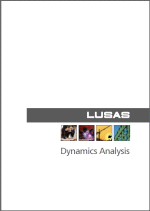Course Summary:
 A two-day course aimed at all engineering
disciplines, covering the
theoretical and practical considerations of linear dynamic analysis and consists equally
of presentations and ‘hands-on’ sessions. A two-day course aimed at all engineering
disciplines, covering the
theoretical and practical considerations of linear dynamic analysis and consists equally
of presentations and ‘hands-on’ sessions.
Who should attend:
LUSAS users familiar with linear static analysis, with a requirement for
dynamics.
-
Delegates
should ensure that they are familiar with linear static
structural analysis using LUSAS prior to attending this
course.
-
The 'LUSAS for
Structural and Bridge Applications' training course is
provided for first time users of LUSAS, and those who wish to
extend and improve their linear analysis knowledge and
modelling capabilities for structural and bridge engineering
applications.
See LUSAS
Training Courses for details.
Course Dates
| Dates |
Location |
Duration |
Cost
(GBP) |
Booking |
| TBA
March 2021 |
Kingston
upon Thames, UK |
2
days |
£350 |
Not
available for booking |
| TBA
June 2021 |
Kingston
upon Thames, UK |
2
days |
£350 |
Not
available for booking |
| TBA
September 2021 |
Kingston
upon Thames, UK |
2
days |
£350 |
Not
available for booking |
| TBA
December 2021 |
Kingston
upon Thames, UK |
2
days |
£350 |
Not
available for booking |
Note: The 2-day LUSAS Dynamics
analysis courses run immediately before the 3-day LUSAS Nonlinear Analysis
courses.
Some delegate
feedback from LUSAS scheduled training courses:
-
“This
class was excellent and one of the best training courses that I
have taken." (Tim E.)
-
“Very
good demonstrations/teachers with a good variety of hands-on
examples.” (Douglas R.)
-
"The
instructor was phenomenal! Engaged, energetic, helpful and
friendly! Could not have asked for a better one." (Joe K.)
Course Details:
Day 1:
Eigenvalue Extraction Analysis (DYN-1)
The starting point of all dynamic analyses is a natural frequency
analysis.
- Eigenvalue extraction
- Subspace iteration
- Guyan reduction
- Inverse iteration with shifting
- Lanczos eigen-extractions
- Nonlinear eigenvalue techniques
Interactive Modal Dynamics (DYN-2)
Vibrational analyses may be performed as a post-processing exercise
following a natural frequency analysis. This covers both frequency and time-domain
analyses.
- Assumptions, calculations and general procedures
- Modal excitation and modal damping
- Calculating results
- Power spectrum and seismic response
Day 2:
Analytical Modal Dynamics (DYN-3)
More complex modal analyses may be carried out ‘off-line’
so-to-speak, in LUSAS. This is discussed along with issues arising from damping in the
structure.
- Damping
- Spectral response analysis
- Harmonic response analysis
Modal Synthesis & Transient Dynamics (DYN-4)
Looks at ways of dividing the structure into component parts, or
superelements as they are more commonly known, and carrying out dynamic analyses on the
components rather than the whole. Additionally, time-stepping techniques are explored for
problems with time-dependent loads.
- Modal synthesis
- Transient dynamic analysis
- Implicit and explicit methods
- Dynamic analysis control
|